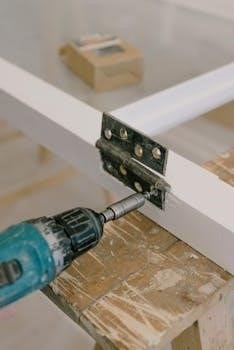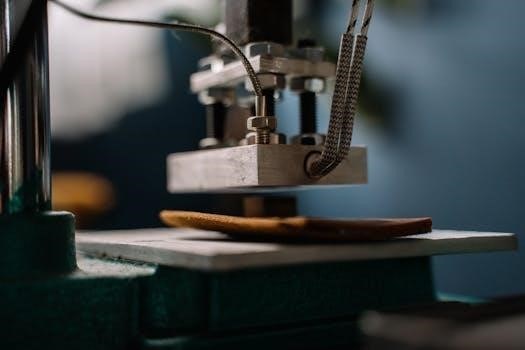Lansinoh Manual Breast Pump Assembly⁚ A Comprehensive Guide

Welcome! This comprehensive guide provides detailed instructions for assembling your Lansinoh Manual Breast Pump. Proper assembly is crucial for effective and comfortable pumping. This guide covers all aspects‚ ensuring a smooth experience for breastfeeding mothers using this convenient manual pump.
The Lansinoh Manual Breast Pump is designed with the needs of breastfeeding mothers in mind‚ offering a convenient and portable solution for expressing breast milk. Ideal for occasional use‚ whether at home or on the go‚ this pump is a valuable tool for mothers who appreciate simplicity and efficiency.
This manual pump features two distinct modes⁚ Let-Down Mode and Expression Mode. These modes can be easily switched between by adjusting the handle’s position. The Let-Down Mode gently stimulates milk flow‚ mimicking a baby’s initial suckling. Once the milk flow has begun‚ you can switch to Expression Mode to efficiently express and collect milk.
The Lansinoh Manual Breast Pump is comfortable‚ silent‚ and easy to carry‚ making it a discreet option for pumping. It is also an excellent backup for mothers who primarily use electric pumps. Its ease of assembly and cleaning further enhance its appeal‚ ensuring a hygienic and hassle-free experience. With the Lansinoh Manual Breast Pump‚ mothers can confidently manage their breastfeeding journey.
Lansinoh Manual Breast Pump Parts Overview
Understanding the different parts of your Lansinoh Manual Breast Pump is essential for proper assembly and effective use. The pump consists of several key components‚ each playing a vital role in the milk expression process.

First‚ there’s the pump body‚ which serves as the main structure to which other parts attach. The ComfortFit™ flange‚ available in different sizes‚ ensures a comfortable and secure fit against the breast. Next‚ the diaphragm and diaphragm stem work together to create the suction needed for milk expression. The pump handle connects to the diaphragm stem and is used to manually create suction.
Additionally‚ the white valve is a small but crucial component that controls milk flow‚ preventing backflow. The bottle stand provides stability‚ preventing spills during and after pumping. Finally‚ the Lansinoh breast milk storage bottle collects the expressed milk‚ ready for storage or feeding. Familiarizing yourself with these parts ensures correct assembly‚ optimal performance‚ and easy maintenance of your Lansinoh Manual Breast Pump.
Essential Cleaning and Sterilization Before Assembly
Prior to the first use‚ and regularly thereafter‚ meticulous cleaning and sterilization of your Lansinoh Manual Breast Pump parts are paramount for your baby’s health. Washing your hands thoroughly is the first step in ensuring a hygienic process. Disassemble all the pump components carefully‚ referring to the parts overview for guidance.
Wash each part with warm‚ soapy water‚ using a mild dish soap. Rinse thoroughly under running water to remove any soap residue. After washing‚ sterilize the parts to eliminate any remaining bacteria or germs. Sterilization can be achieved through various methods‚ including boiling the parts in water for five minutes‚ using a steam sterilizer‚ or utilizing sterilizing bags specifically designed for breast pump components.
Ensure all parts are completely dry before assembling the pump. Proper cleaning and sterilization protect your baby from potential infections‚ making this step an indispensable part of your pumping routine. Always consult the Lansinoh manual for detailed cleaning and sterilization instructions.
Step-by-Step Assembly Instructions for the Lansinoh Manual Breast Pump
With clean and sterilized parts‚ you can now assemble your Lansinoh Manual Breast Pump. Begin by attaching the pump body to the breast shield. Ensure they securely click together‚ creating a tight seal to maintain proper suction. Next‚ connect the diaphragm to the pump body‚ making sure it is correctly aligned and firmly in place. This component is crucial for generating the necessary vacuum for milk expression.
Then‚ attach the pump handle to the diaphragm stem‚ adjusting the position according to your preferred pumping mode – let-down or expression. The correct handle placement is essential for switching between these modes effectively. Finally‚ attach the bottle to the pump body‚ ensuring it is tightly secured to prevent any leaks during pumping. Double-check all connections to confirm a secure and airtight assembly before each use.
Refer to the Lansinoh manual for visual aids and specific details to ensure correct assembly. If any part feels loose or misaligned‚ disassemble and reassemble carefully.
Proper Handle Positioning for Let-Down and Expression Modes
The Lansinoh Manual Breast Pump features two distinct modes⁚ Let-Down and Expression‚ each requiring specific handle positioning for optimal performance. For Let-Down Mode‚ designed to stimulate milk flow‚ position the handle in a way that allows for short‚ quick pumps. This mimics the initial sucking pattern of a baby‚ encouraging milk to release. The handle should feel comfortable and allow for rapid‚ gentle movements.
Once milk flow is established‚ switch to Expression Mode. This mode requires a different handle position‚ typically involving longer‚ deeper pumps. Adjust the handle to allow for a full range of motion‚ enabling you to create stronger suction. This helps to efficiently extract milk once the let-down has occurred. Experiment with different handle positions within each mode to find what feels most comfortable and effective for you.

Remember‚ switching between modes is easy with the Lansinoh Manual Breast Pump‚ simply adjust the position of the handle on the stem. This flexibility allows you to tailor your pumping experience to your body’s needs.
Centering the Pump and Applying Gentle Pressure
Proper positioning of the Lansinoh Manual Breast Pump is crucial for effective and comfortable milk expression. Begin by ensuring the pump flange is centered correctly over your nipple. The nipple should move freely within the flange tunnel without rubbing against the sides. A well-centered pump prevents discomfort and maximizes milk output. Take a moment to visually inspect the alignment before initiating pumping.
Once centered‚ apply gentle‚ even pressure to create a secure seal. Avoid pressing too hard‚ as excessive pressure can cause discomfort and hinder milk flow. The goal is to create a comfortable‚ airtight seal between the flange and your breast. This seal is essential for generating the suction needed to express milk efficiently. If you experience any pinching or pain‚ readjust the pump and reduce the pressure.
Remember‚ comfort is key to successful pumping. Finding the right balance between centering and gentle pressure will make your pumping sessions more productive and pleasant.
Tips for Comfortable and Efficient Pumping
Achieving comfortable and efficient pumping with the Lansinoh Manual Breast Pump involves several key strategies. First‚ ensure you are in a relaxed and comfortable environment. Stress can inhibit let-down‚ making pumping less effective. Consider playing calming music or looking at photos of your baby to help stimulate milk flow.
Experiment with different pumping rhythms and suction levels to find what works best for you. Start with gentle‚ short pumps to stimulate let-down‚ then switch to longer‚ deeper pumps once milk begins to flow. Proper hydration is also crucial; drink plenty of water throughout the day to maintain milk supply. Warm compresses or gentle breast massage before pumping can further encourage let-down and improve milk output.
Additionally‚ ensure the breast shield fits correctly to prevent discomfort and maximize efficiency. Remember‚ consistent and comfortable pumping sessions will contribute to a more successful breastfeeding journey. Always prioritize your comfort and well-being during each session.
Switching Between Stimulation and Expression Modes
The Lansinoh Manual Breast Pump is designed with two distinct modes to optimize milk expression⁚ Stimulation Mode and Expression Mode. Understanding when and how to switch between these modes is essential for efficient pumping. Stimulation Mode‚ also known as Let-Down Mode‚ mimics the baby’s initial rapid sucking to trigger milk release. To initiate this mode‚ position the handle on the stem according to the pump’s instructions‚ typically involving shorter‚ quicker pumps.
Once milk flow begins‚ transition to Expression Mode. This mode supports deeper‚ more prolonged suction to efficiently extract milk. Adjust the handle position as directed to engage Expression Mode‚ usually involving slower‚ more deliberate pumps. Pay attention to your body’s cues; if milk flow slows down in Expression Mode‚ revert to Stimulation Mode for a short period to encourage another let-down.
The ability to seamlessly switch between these modes allows you to customize your pumping experience‚ maximizing milk output while maintaining comfort. Experiment with different patterns to find what works best for your individual needs.
Understanding Suction Levels and Adjustment
The Lansinoh Manual Breast Pump offers adjustable suction levels‚ allowing you to customize the pumping experience to your comfort and needs. Understanding how to control and adjust these levels is crucial for efficient and pain-free milk expression. The suction level is determined by the force and frequency with which you squeeze the pump handle.

Start with gentle‚ short squeezes to initiate milk flow and gradually increase the pressure as needed. Pay close attention to your body’s signals; if you experience any discomfort or pain‚ immediately reduce the suction by lessening the force of your squeezes. It’s important to find a balance between effective milk removal and personal comfort. Experiment with different rhythms and pressures to discover what works best for you.
Remember‚ higher suction does not always equate to more milk. Often‚ a comfortable and consistent rhythm is more effective in stimulating milk flow. Regular adjustments may be necessary throughout the pumping session as your breasts empty and your sensitivity changes.
Breast Milk Storage and Thawing Guidelines
Proper storage and thawing of breast milk are essential to maintain its quality and safety for your baby. After expressing milk with your Lansinoh Manual Breast Pump‚ immediately transfer it to a clean‚ BPA-free storage container or breast milk storage bag. Label each container with the date and time of expression to ensure you use the oldest milk first.
Freshly expressed breast milk can be stored at room temperature (up to 77°F or 25°C) for up to 4 hours. In the refrigerator (40°F or 4°C)‚ it can be stored for up to 4 days. For longer storage‚ freeze the milk in portions suitable for individual feedings. Frozen breast milk can be stored in a standard freezer for up to 6 months or in a deep freezer for up to 12 months.
To thaw frozen breast milk‚ place it in the refrigerator overnight or hold it under lukewarm running water. Never microwave breast milk‚ as this can create hot spots and destroy valuable nutrients. Once thawed‚ breast milk should be used within 24 hours and should not be refrozen.
Troubleshooting Common Assembly Issues
Assembling the Lansinoh Manual Breast Pump is generally straightforward‚ but occasional issues may arise. One common problem is difficulty achieving suction. Ensure all parts are correctly connected and tightly sealed. Check the white valve and membrane for any tears or damage‚ as these can significantly impact suction. Make sure the pump is centered over your nipple.
If the handle is difficult to move‚ double-check that all components are properly aligned. If you experience discomfort during pumping‚ ensure that the breast shield size is appropriate for your nipple. A shield that is too small or too large can cause pain and reduce milk output. Experiment with different handle positions to find the most comfortable and effective mode for let-down and expression.
If you notice milk leaking from the pump‚ inspect the connections between parts to ensure they are secure. If problems persist‚ consult the Lansinoh Manual Breast Pump user manual for further guidance or contact Lansinoh customer support for assistance.
Maintaining Your Lansinoh Manual Breast Pump
Proper maintenance of your Lansinoh Manual Breast Pump ensures its longevity and optimal performance. After each use‚ disassemble all parts that come into contact with breast milk. Wash these components thoroughly with warm‚ soapy water. Use a mild dish soap and rinse well under running water to remove any milk residue. A bottle brush can be helpful for cleaning hard-to-reach areas.
Periodically sterilize the pump parts‚ especially if your baby is under three months old‚ premature‚ or has a weakened immune system. Sterilization can be achieved by boiling the parts in water for five minutes‚ using a microwave steam bag‚ or using a dishwasher with a sanitizing cycle.
Allow all parts to air dry completely on a clean surface before reassembling. Inspect the components regularly for signs of wear and tear‚ such as cracks or discoloration. Replace any damaged parts immediately to maintain proper function and hygiene. Store the pump in a clean‚ dry place when not in use to prevent contamination and prolong its lifespan.


